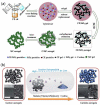Carbon Material-Based Aerogels for Gas Adsorption: Fabrication, Structure Design, Functional Tailoring, and Applications
- PMID: 36144967
- PMCID: PMC9504413
- DOI: 10.3390/nano12183172
Carbon Material-Based Aerogels for Gas Adsorption: Fabrication, Structure Design, Functional Tailoring, and Applications
Abstract
Carbon material-based aerogels (CMBAs) have three-dimensional porous structure, high specific surface area, low density, high thermal stability, good electric conductivity, and abundant surface-active sites, and, therefore, have shown great application potential in energy storage, environmental remediation, electrochemical catalysis, biomedicine, analytical science, electronic devices, and others. In this work, we present recent progress on the fabrication, structural design, functional tailoring, and gas adsorption applications of CMBAs, which are prepared by precursor materials, such as polymer-derived carbon, carbon nanotubes, carbon nanofibers, graphene, graphene-like carbides, fullerenes, and carbon dots. To achieve this aim, first we introduce the fabrication methods of various aerogels, and, then, discuss the strategies for regulating the structures of CMBAs by adjusting the porosity and periodicity. In addition, the hybridization of CMBAs with other nanomaterials for enhanced properties and functions is demonstrated and discussed through presenting the synthesis processes of various CMBAs. After that, the adsorption performances and mechanisms of functional CMBAs towards CO2, CO, H2S, H2, and organic gases are analyzed in detail. Finally, we provide our own viewpoints on the possible development directions and prospects of this promising research topic. We believe this work is valuable for readers to understand the synthesis methods and functional tailoring of CMBAs, and, meanwhile, to promote the applications of CMBAs in environmental analysis and safety monitoring of harmful gases.
Keywords: aerogels; carbon materials; functional tailoring; gas adsorption; hybrid materials.
Conflict of interest statement
The authors declare no conflict of interest.
Figures











Similar articles
-
Two-dimensional material-based functional aerogels for treating hazards in the environment: synthesis, functional tailoring, applications, and sustainability analysis.Nanoscale Horiz. 2022 Jan 31;7(2):112-140. doi: 10.1039/d1nh00633a. Nanoscale Horiz. 2022. PMID: 35044403 Review.
-
Polymer/Carbon-Based Hybrid Aerogels: Preparation, Properties and Applications.Materials (Basel). 2015 Oct 9;8(10):6806-6848. doi: 10.3390/ma8105343. Materials (Basel). 2015. PMID: 28793602 Free PMC article. Review.
-
Recent advance in the fabrication of carbon nanofiber-based composite materials for wearable devices.Nanotechnology. 2021 Aug 13;32(44). doi: 10.1088/1361-6528/ac18d5. Nanotechnology. 2021. PMID: 34325413 Review.
-
Recent advances in the hybridization of cellulose and carbon nanomaterials: Interactions, structural design, functional tailoring, and applications.Carbohydr Polym. 2022 Mar 1;279:118947. doi: 10.1016/j.carbpol.2021.118947. Epub 2021 Nov 30. Carbohydr Polym. 2022. PMID: 34980360 Review.
-
Processing of aerogels and their applications toward CO2 adsorption and electrochemical reduction: a review.Environ Sci Pollut Res Int. 2022 Jul;29(32):47942-47968. doi: 10.1007/s11356-022-20355-2. Epub 2022 May 11. Environ Sci Pollut Res Int. 2022. PMID: 35545748 Review.
Cited by
-
Creation of Composite Aerogels Consisting of Activated Carbon and Nanocellulose Blended with Cross-Linked Biopolymers: Application as Ethylene Scavengers.Polymers (Basel). 2024 Oct 31;16(21):3081. doi: 10.3390/polym16213081. Polymers (Basel). 2024. PMID: 39518287 Free PMC article.
References
-
- Liu H.Y., Du H.S., Zheng T., Liu K., Ji X.X., Xu T., Zhang X.Y., Si C.L. Cellulose based composite foams and aerogels for advanced energy storage devices. Chem. Eng. J. 2021;426:130817. doi: 10.1016/j.cej.2021.130817. - DOI
-
- Wei G., Zhang J.M., Usuelli M., Zhang X.F., Liu B., Mezzenga R. Biomass vs inorganic and plastic-based aerogels: Structural design, functional tailoring, resource-efficient applications and sustainability analysis. Prog. Mater. Sci. 2022;125:100985. doi: 10.1016/j.pmatsci.2021.100915. - DOI
-
- Wang C.J., Liang W.D., Yang Y.Y., Liu F., Sun H.X., Zhu Z.Q., Li A. Biomass carbon aerogels based shape-stable phase change composites with high light-to-thermal efficiency for energy storage. Renew. Energy. 2020;153:182–192. doi: 10.1016/j.renene.2020.02.008. - DOI
Publication types
Grants and funding
LinkOut - more resources
Full Text Sources

